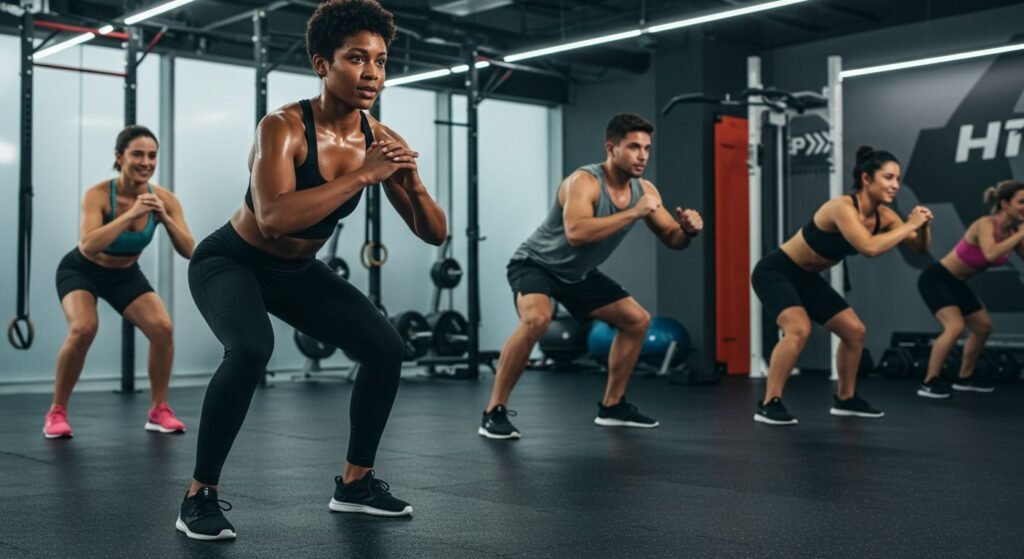What is HIIT?
High-Intensity Interval Training, or HIIT, is a workout strategy that alternates short periods of intense anaerobic exercise with less intense recovery periods. Originally designed for elite athletes, HIIT has gained popularity among fitness enthusiasts for its efficiency and effectiveness. Unlike typical aerobic exercises, which maintain a steady pace, HIIT pushes the body to perform at near-maximum capacity for brief, split-second bursts, followed by brief recovery phases. This cycle helps improve cardiovascular fitness, muscular endurance, and promotes fat loss, providing a robust workout in a shorter time compared to conventional exercise routines.
Short high intensity exercises
The hallmark of HIIT Training is its short, yet extreme, periods of exertion. These segments are usually between 20 to 90 seconds, designed to push the heart rate to 80-95% of its maximum. This method hinges on the principle that short bursts of maximum effort, followed by minimal rest, forces the body to adapt quickly, burning more calories and improving performance. Exercises typically integrated into HIIT Training routines include sprints, burpees, jumping jacks, and high-knee runs, each selected for their ability to ramp up intensity swiftly.
Elevated heart rate
An elevated heart rate is an integral part of the HIIT Training approach. During intense phases of HIIT, the heart rate should reach near-maximum levels, which means different things for individuals based on their age and fitness levels. This surge in heart rate is essential for maximizing the caloric burn and enhancing cardiovascular health. Notably, even during the low-intensity phases, an individual’s heart rate remains elevated, which contributes to the “afterburn effect” often associated with HIIT Training. This period of increased calorie burn post-exercise is technically referred to as excess post-exercise oxygen consumption (EPOC).
What is HIIT Training for?

HIIT Training serves multiple purposes and is designed to cater to various fitness goals. Primarily, it is used to enhance cardiovascular endurance and muscular strength while also excelling in weight loss efforts. HIIT’s unique characteristic is its ability to burn a significant number of calories in a short period, making it desirable for those with time constraints. Additionally, HIIT Training can act as a stimulating alternative for athletes looking to improve their speed and agility, as well as individuals aiming to boost their overall fitness level. HIIT Training can be adjusted in terms of intensity and duration to fit the capabilities of each participant, making it an adaptable and inclusive workout method.
| Goal | Description | Benefits |
|---|---|---|
| Cardiovascular Health | Improves heart and lung function | Enhances endurance |
| Weight Loss | Burns more calories in less time | Reduces body fat |
| Muscle Strength | Increases power and strength | Builds muscular endurance |
| Time Efficiency | Short but effective workouts | Suitable for busy schedules |
What are the main health benefits of HIIT?
The health advantages of HIIT Training are myriad, attracting a wide spectrum of fitness enthusiasts. Primarily, HIIT increases metabolic rate, both during and after exercise, enhancing energy expenditure even when at rest. This contributes directly to its effectiveness in weight management and fat loss. Moreover, HIIT Training has been shown to improve cardiovascular health significantly, as it boosts heart and lung function, decreases blood pressure, and improves insulin sensitivity, which helps in better glucose metabolism. Regularly engaging in HIIT Training can also promote the release of endorphins, leading to improved mental well-being and reduced stress.
Does HIIT really help you lose weight?
HIIT Training is revered for its ability to facilitate weight loss more effectively than traditional cardio exercises. Due to its high intensity, HIIT not only incinerates calories during the workout but also elevates calorie burning in the following post-exercise hours. This prolonged calorie burn is a critical factor in reducing overall body fat and achieving weight loss. Furthermore, HIIT Training tends to target abdominal fat specifically, which is linked to various health complications. The combination of enhanced metabolism, aggressive calorie burning, and the innovative nature of the workout makes HIIT Training a powerful tool for those looking to shed excess weight.
Can anyone do HIIT?
While HIIT Training is an efficient workout option, it may not be suitable for everyone without prior consideration. It’s essential to assess personal fitness levels, as HIIT requires a functional base level of fitness to minimize injury risk. Those with a sedentary lifestyle or chronic health conditions should consult health professionals before incorporating HIIT Training into their routines.
Exercise should be regarded as a tribute to the heart. – Gene Tunney
Can children and teenagers practice?
Children and teenagers can participate in HIIT, but it should be tailored to their developmental stages. It’s crucial to emphasize fun and safe movements, avoiding overly intense routines that might strain developing bodies. Supervised and structured HIIT sessions can improve physical fitness, sports performance, and instill a lifelong habit of regular exercise in younger individuals.
Can people with illnesses and adverse health conditions practice?
Individuals with existing health conditions should approach HIIT with caution. Consulting a healthcare provider is necessary to evaluate whether HIIT can be safely incorporated into their routine. HIIT’s high-intensity nature might not be suitable for everyone, especially those with cardiovascular diseases or joint problems. Modifying the intensity and duration of exercises can make HIIT more accessible, ensuring it’s performed safely without exacerbating any health issues.
What are the differences between HIIT?

Despite its overarching principles, HIIT can be varied by integrating different exercises and structures, each providing unique health benefits. Understanding these differences can help participants select the most beneficial HIIT style for their fitness goals.
Aerobic training
Traditional aerobic training focuses on sustained exercises with moderate intensity over extended periods. In contrast, HIIT combines anaerobic and aerobic exertion, significantly increasing the heart rate over brief cycles. This variation leads to a contrast in results; aerobic training enhances cardiovascular endurance while HIIT promotes rapid calorie expenditure and muscle toning in shorter sessions.
Circuit training
Circuit training involves completing a sequence of exercises with minimal rest in between. While both HIIT and circuit training are efficient in maintaining excitement within a workout, HIIT emphasizes pushing maximum effort in short bursts, whereas circuit training maintains a consistent, moderate intensity. HIIT typically focuses more on cardiorespiratory aspects, and circuit training often aims for muscular endurance.
Crossfit
CrossFit incorporates various training styles, including HIIT, strength training, and functional movements. HIIT, within CrossFit, often forms part of a “Workout of the Day” (WOD) but stands alone in its efficacy to prioritize maximal effort over shorter durations. CrossFit might accommodate HIIT-style workouts, but it is generally more holistic, incorporating weightlifting, gymnastics, and endurance elements within its regimen.
How to start practicing HIIT?

For those new to HIIT, embarking on this intense workout journey requires careful planning and consideration to ensure safety and effectiveness in achieving personal fitness objectives.
Intensity and safety
Starting with an understanding of one’s physical limits is paramount. Beginners should gradually introduce HIIT, beginning with lower-intensity exercises to build up stamina and familiarity. Paying close attention to the body’s response, particularly in terms of heart rate and fatigue, can mitigate injury risk.
Variety of exercises
To maintain interest and challenge different muscle groups, incorporating a variety of exercises into HIIT routines is essential. From sprints and jumping exercises to strength-based moves like squats and push-ups, diversity in exercises can prevent workout monotony and enhance comprehensive fitness improvements.
1- Sprints: Short bursts at near-maximal speed.
2- Squats and lunges: For muscle endurance and strength.
3- Burpees and jumping jacks: To increase heart rate quickly.
4- Mountain climbers: Cardiovascular and core strengthening.
Frequency and consistency
Consistency is vital in reaping HIIT’s benefits, but it must be balanced with adequate recovery. Typically, engaging in HIIT workouts 2-3 times per week allows muscles to recuperate while fostering cardiorespiratory health. Overexertion can lead to diminished results and increased injury risk, so balancing frequency with rest is crucial.
Proper nutrition
HIIT places high demands on the body’s energy reserves, necessitating a balanced diet rich in proteins, carbohydrates, and healthy fats. Sufficient hydration and nutrient intake before and after workouts support performance levels and vital recovery processes, enhancing overall HIIT effectiveness.
Liv Pure – 60 days guarantee
Are you fed up with stubborn fat that won’t budge, endless fatigue, or feeling like your body’s holding you back? Stop waiting for a miracle—Liv-Pure is here to make it happen! This isn’t just a supplement; it’s your ticket to a healthier, leaner, more vibrant life. With Liv-Pure, you can detox your liver, ignite your metabolism, and watch the pounds melt away—all naturally. Don’t settle for less when you can have the best. Let’s dive into why Liv-Pure is the must-have solution you need to take control of your health today!
Conclusion
In summary, High-Intensity Interval Training (HIIT) offers a dynamic, efficient, and effective approach to achieving various fitness objectives, from weight loss to cardiovascular improvements. By stacking short bursts of high-intensity exercises with brief rest intervals, HIIT provides a powerful workout in a fraction of the time required for traditional exercise regimens. While HIIT is largely adaptable, its intensity levels necessitate careful consideration of individual health statuses and fitness levels to avoid injuries. As HIIT continues to rise in popularity, incorporating it under appropriate guidance, along with a balanced diet, can lead to remarkable enhancements in both physical health and overall well-being.
See more, you might like: Unlock the Secrets to Healthy Eating: Transform Your Diet and Boost Your Energy In 2025!
FAQ – Dúvidas Comuns
Can HIIT be done every day?
Performing HIIT daily is not recommended due to its intensity. The muscles and body need recovery time; thus, 2-3 sessions a week are optimal.
Do I need equipment for HIIT?
Equipment is not necessary for HIIT, as bodyweight exercises can suffice. However, weights and other tools can introduce variety.
Is HIIT suitable for beginners?
Yes, HIIT can be adapted for beginners. Starting with lower intensity and gradually increasing can help newcomers acclimate.
How long should a HIIT session last?
A typical HIIT session lasts between 20-30 minutes, including warm-up and cooldown, depending on the individual’s fitness level.
Is warming up necessary before HIIT?
Warming up is essential before HIIT to prepare the body, enhance performance, and reduce the risk of injury.


